Database Management
Public defenders and public defense staff frequently expressed a need for better case management and database management software. We outline the design priorities and constraints for technologists interested in workplace software systems for public defense offices. We also highlight opportunities for policy change to improve outcomes for public defense offices.
Poor information management systems were a significant blocker for public defenders. Throughout their workflows, they’re forced to interact with disparate databases with overlapping and poorly indexed information about client details, case information, custody status, a client’s criminal history, and court filings. Many public defenders had separate databases for transferring and indexing discovery. Most public defenders lacked adequate internal document-sharing solutions, and many talked about tracking things in the office by exchanging Excel spreadsheets via email or note-taking on a shared ledger. They also lacked task management or calendar systems. This chaotic and user-unfriendly environment wastes time and may let critical deadlines and information fall through the cracks.
The amount of time … that I spent doing, I don’t mean this derisively, but just secretarial tasks, you know, like putting crap into paper files … that was an insane amount of time
– Former Misdemeanor Public Defender
Storyboard
Explore this depiction of a public defender’s experiences managing a case, and specifically writing a motion for court, using case management software and databases.
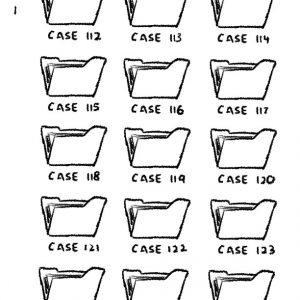
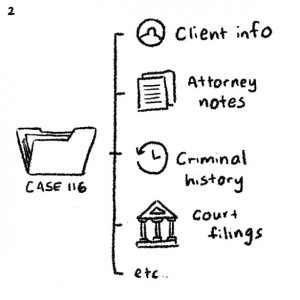
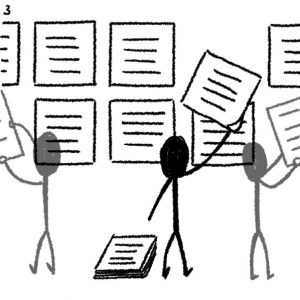
1. A public defender has to keep track of 150 cases they are responsible for. Of those cases, they know that in one case they need to write a motion in court.
2. In preparation for writing a motion in court, the public defender needs several types of information about the case, including client details, attorney notes, criminal history, custody status, court filings, and minute orders.
3. To get started writing the motion, they also need to access a shared repository with materials not located in the previously referenced databases.
A shared repository might include: templates for writing motions and other court filings, training and educational material, evidence (such as body camera footage), and files that are too large to fit into the databases.
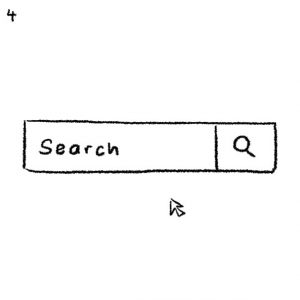
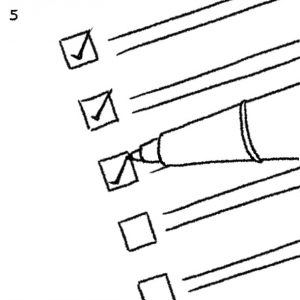
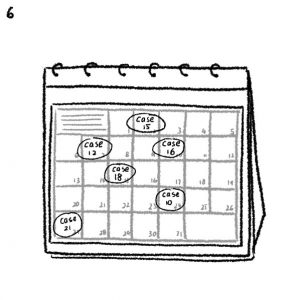
4. The public defender wants to make their motion as compelling as possible. To do so, they might need to cite information from other cases. They use an online legal research suite (such as Westlaw or CEB) for relevant case details.
5. The public defender finishes writing the motion. Now they need to ensure that the motion correctly cites facts about the client, their court and criminal history, other case references, and exhibits of evidence. They work with public defense staff, such as paralegals, to validate this before filing the motion.
6. Ideally, any meaningful or relevant data should be easily managable so that public defenders can easily present them in court.
Issues & Needs
STEP
ISSUES
NEEDS

1. Tracking cases and writing motions
Unmanageable Caseload Volume
- Public defenders handle a high volume of cases, all at different stages of development
- Depending on the sophistication of the public defense office, public defenders may have inconsistent infrastructure (such as spotty Internet)
- A manageable case load quota to adequately dedicate mind and time share to
- Reliable source of information for deadlines and responsibilities associated with all of their cases
- Baseline, reliable technical infrastructure to manage their work
We have very poor database management tools, I would say. We have very poor tools to collate disparate sources of information
– Federal Public Defender

2. Gathering case-worthy information to prepare a motion
Lack of a consolidated database
- Information relevant to writing a motion may be scattered across multiple databases
- Across these multiple databases, public defenders and staff must do repetitive work with regard to inputting data about a case
- Access a variety of case materials such as client details, attorney notes, criminal history, custody status, court filings, and minute orders
- Ability to find relevant information for a case without logging into and out of multiple databases
It’s just like, we have to access like three or four or like five different databases, but seem like they should be consolidated
– State Public Defender

3. Accessing a shared repository to prepare a motion
Locating & Referencing additional Material
- For materials not available in databases, such as training resources and excessively large files, public defenders must access the shared office repositories where these are stored
- These files are typically in non-standardized name formats and contain incomplete data entries by various editors, making it hard to locate and use when required
- Access to training resources on demand
- Ability to collate latest information on their client, synced with database information
- Ability to reference materials from external databases
- Standardized file-naming conventions within shared online and offline repositories
I spend 3-7 hours a day just standardizing file formats
– Paralegal in a Public Defense office

4. Citing details from other cases
Citing & Discovering Case Law
- Public defenders must reference relevant case law to make their written motions as compelling as possible. This requires navigating legal research suites for said case law
- It can be particularly difficult to find relevant case law for novel and unfamiliar technologies such as facial recognition or ShotSpotter
- Central accessible location for case law relevant to a public defender’s work, especially for unfamiliar technologies
- Search online legal research suites (such as Westlaw or CEB) for relevant case details

5. Verifying facts prior to filing the motion
Evidence Verification
- Before filing a written motion, public defenders and public defense staff must verify all of their citations (such as court dates, evidence/exhibits, and case law), which can be time-consuming given the multiple databases and repositories they use to cross-reference their case
- A resource to verify or ensure of the veracity of citations within a written motion using data located in different databases, repositories, drives, search suites

6. Meeting deadlines and juggling other active cases
Tackling Digital Evidence Management
- After filing a motion, the public defender must stay up to date with proceedings in that case, and additionally all other active cases, doing so with no system to assist them or keep track of these proceedings.
- Track all current and active cases and proceedings
- Manage case deadlines in a high stress and time-pressured environment without hitting burnout
- Avoid burdensome data-entry tasks so as to focus on responsibilities oriented toward clients
I have … five clients whose cases have all been adjourned because the judge who’s assigned to them is literally on vacation for a month … and because they’ve been administratively adjourned, I have no court date for them and I have no way of looking it up online
– Misdemeanor Public Defender
Solutions
Below, we provide a few potential approaches to addressing public defenders’ challenges using case management and database management software. We encourage you to consider these approaches and develop your own.
- Work with one jurisdiction to build a case management system, taking in information from public databases and allowing storage and management. Important features include:
- Single sign-on
- Ability to edit, tag, make notes, and add annotations
- Differential user roles and permissions to authenticate multiple users
- User authentication and activity history log to track changes made
- Integration with existing public databases and record-keeping systems
- Task management system auto-populated from existing court scheduling solutions
- Secured end-to-end data encryption to protect sensitive client information
- Work with court systems to digitize records and complete more procedural paperwork online
- Regular quarterly trainings for all public defenders to better understand technical systems and laws that govern their use
Constraints
General Constraints
Database Management Specific Constraints
Lack of resources: Public defense offices have limited budgets and staff to acquire and maintain new technologies.
Privacy and security requirements: Privacy is critical. Not only are the costs of breaches of client privacy extremely high, but public defenders should only have access to surveillance data and case information used in their own cases.
Heterogeneous IT environments: The basic technical environment differs widely between public defense offices in different jurisdictions and in different regions. Most of the Bay Area public defenders we spoke to had laptops, phones, wifi, and VPNS. In other areas, public defenders relied on landlines and aging desktops, and were forced to use their personal data plans for communicating with clients and downloading data.
How to keep prosecutors out: The judicial system is adversarial, and public defenders are wary of technologies, particularly evidence processing or central repositories of information which may be accessed by prosecutors.
High Stakes: Case management systems may detail when arrests are made, court dates are scheduled, and when clients (or attorneys) are notified about court proceedings. Mix-ups in these record-keeping systems may lead to legal consequences for clients. For example, a confusing date entry interface in an Alameda County case management system led to wrongful arrests.
Heterogeneity in external databases: External databases may be jurisdiction-specific.
Heterogeneity of organizational design: Some public defense offices use a “horizontal structure” where each attorney handles a specific part of many cases, while others use a vertical structure where one attorney works a case throughout its entire lifetime.
Social risks of AI-Based Solutions: Any AI-based solutions deployed to analyze case history law, assist with the discovery process, or summarize evidence should be tested for failures in the design of their AI models and system in terms of bias in existing datasets, perceived objectivity, and impartiality that may introduce more social risks and discrimination in the criminal justice system.
Policy Implications
I feel [with some technical solutions] … it’d be great to have a system where people are texted before their court date, but even better would be a system where 90% of the court dates don’t happen because they’re totally useless
– Felony Public Defender
BIG PICTURE REFORMS
Big Picture Reforms
- Reduce caseloads by diverting cases away from the criminal justice system
- Increase public defense budgets. Remove fees on defendants as a source of public defense funding
Specific Reforms to Improve Public Defenders’ Ability to Share Information
- Requirements for record-keeping in public defense offices [2]
- Reforms of court systems (particularly around lower crimes) to remove bureaucracy and digitize records
- Rules requiring transparency in development of records databases

